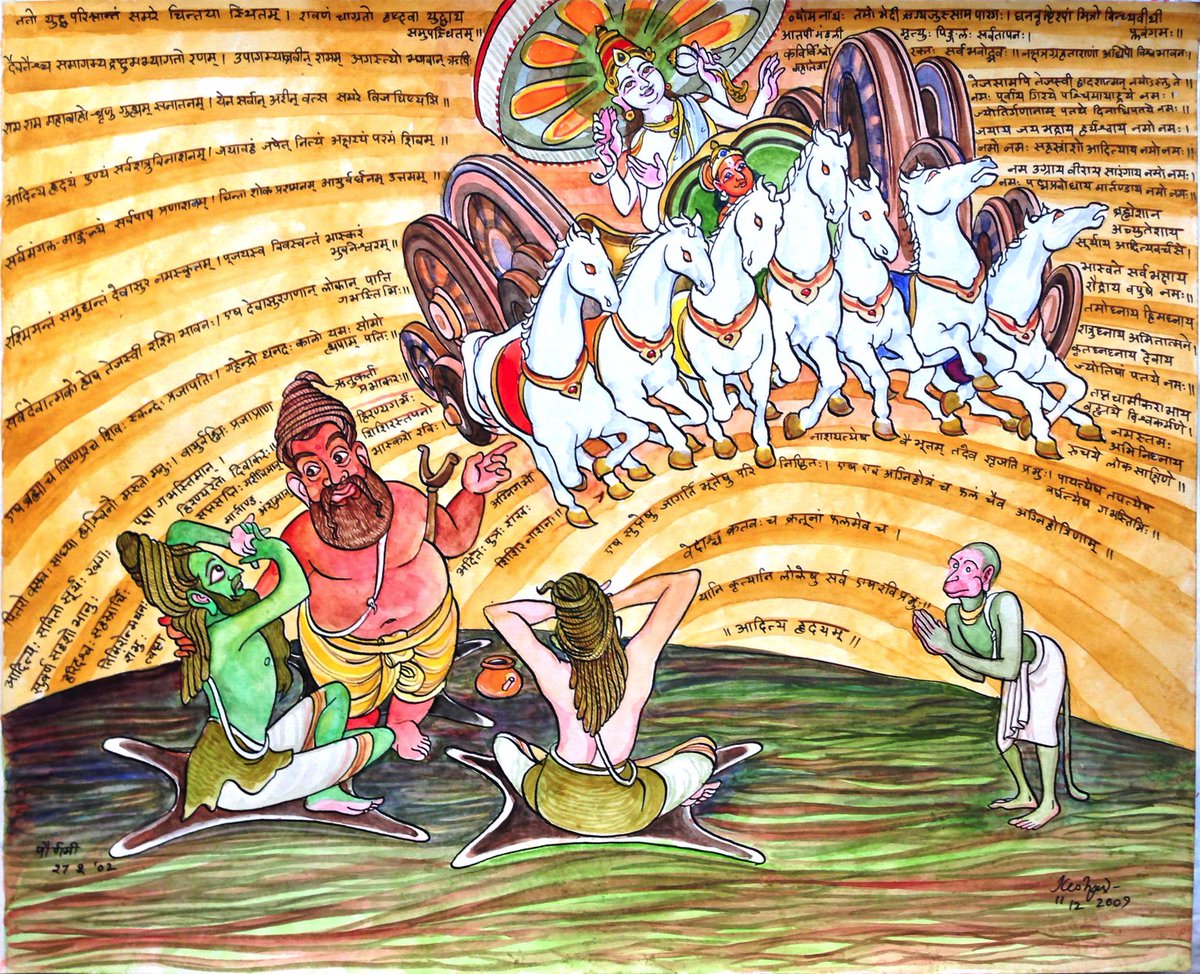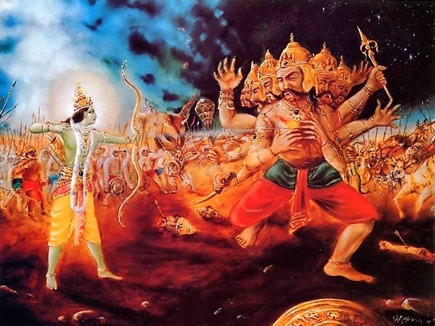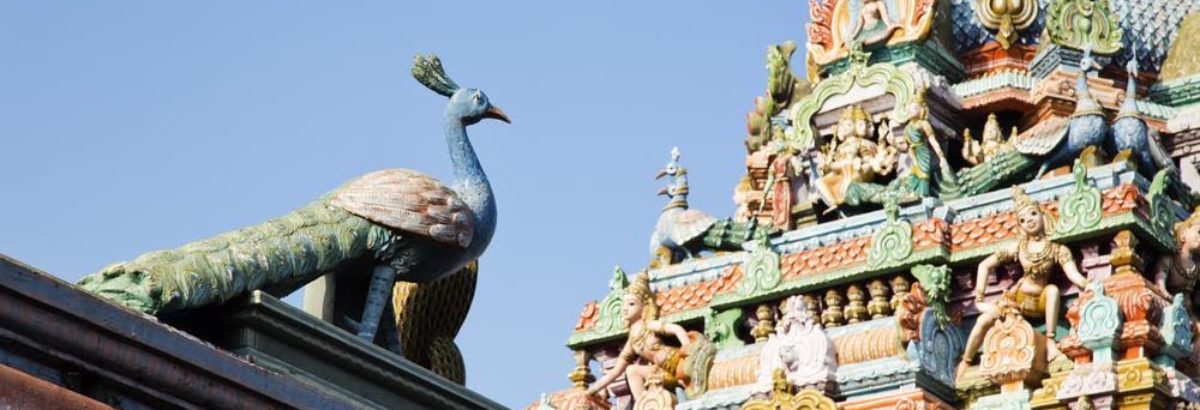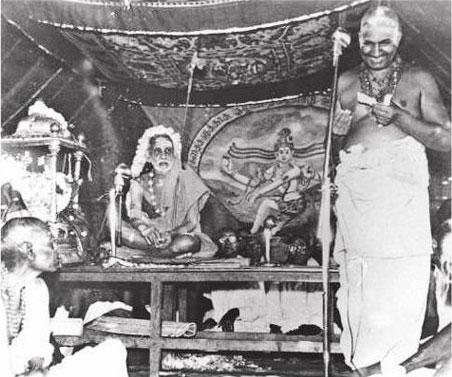Namaste All.
Aditya Hrdayam
Then the all-knowing Sage Agastya, who had come and joined the Gods to witness the fierce battle, seeing Rama who was lost in deep thought, utterly exhausted in battle and yet facing Ravana who was ready for a fresh encounter, spoke to Him.

Saga Agastya says… Oh Rama, mighty armed Sri Rama listen to this eternal secret whereby your shall vanquish in battle all your foes.
This Holy hymn to the presiding deity of the Sun, if chanted fervently, will result in the destruction of all your enemies and bring you victory and unending supreme felicity.
It is supreme in that it is a guarantee of all round prosperity, destroyer of all sin, allayer of anxiety and anguish, and bestower of longevity.
Do thou worship with this hymn the one i.e. Sun held in veneration by Devas and Asuras, possessed of golden coloured rays when he has wholly risen in the morning, who eclipses as it were other luminous bodies by his appearance on the firmament, the resplendent Lord of the universe by whose effulgence all else brighten.
He verily represents the totality of all celestial beings. He is self-luminous and is the sustainer of all with his rays. He protects the inhabitants of all the worlds as well as the race of the Devas and Asuras with rays that nourish and energize.
He, the presiding deity of the Sun is really all these – Brahma, the creator, Vishnu the Sustainer and Siva, the destroyer. Skanda the Divine Generalissimo (the annihilator of all foes), Prajapati, the Lord of all creatures, Mahendra, the Kind of the Celestial beings, Kubera, the dispenser of riches, Kala, the Lord of Time, Yama, the Lord of Death, Soma, the one that nourishes, and the Lord of the Waters, God Varuna.
He is also the Pitrs, the Vasus, the Sadhyas, the twin Aswini Devas, the celestial physicians, the Maruts, Manu, Vayu, Agni, the vital air in all created beings, the maker of the six seasons by virtue of His alternating forms of energy and essentially the source of all light, the awakener of knowledge.
He, the Sun is the son of Aditi, the mother of all Devas, the creator of the Universe, the insipirer of action, the courser in the heavens, the sustainer, the illuminator of the directions, the golden hued brilliance, the golden generative fluid, and the maker of the Day.
He is he All pervading one with rays countless, the power behind the seven sense organs, i.e. two eyes, two ears, two nostrils and the tongue and the dispeller of darkness i.e. ignorance. He is the bestower of happiness and prosperity inclusive of absolution, the remover of the misfortunes of His votaries; the infuser of life in the otherwise mundane egg of existence, and the Omnipresent being, whose rays penetrate everywhere.
He is the primordian one who has become the Trinity – The Brahma, Vishnu and Rudra, the ambrosial soothing influence, the storehouse of riches Aiswarya, the usherer in of the Day, the Great teacher, the fire wombed Narayana, the son of Aditi felicity that is supreme and vast like the expanse, and the remover of intellectual stupor or evil mindedness.
He is the Lord of the firmament; the Dispeller of darkness: the Master par excellence of the three Vedas, Rig, Yajur and Sama; He from whom comes the downpour of rain, the friend of the waters, figuratively the friend and benefactor of the pure-minded, crossed the Vindhya range, who sports in the Brahma Nadi.
He is the one intensely absorbed in creating the cosmos,with form circular , He is the inflictor of death, He is the Yellow coloured one, He is the destroyer of all; He is the Omniscient one whose form is the universe ; and who is exceedingly energetic and the beloved of all and the generator of all action.

He is the Lord of all stars, Planets and constellations and the origin of everything in the universe, the resplendent cause of the lustre of even the brilliant ones, the one sentient being manifest in the twelve forms of the Sun.
- Salutations to Thee.
- Salutations to the presiding deity of Eastern mountain , where the Sun rises.
- Salutations to the presiding deity of Western mountain, where the Sun sets.
- Salutations to the Lord of the stellar bodies and also to the Lord of Day.
- Salutations unto Him that ordains victory in the quest after liberation.
- Salutations to Him, the Sun God, possessed of yellow steeds.
- Salutations to the thousand rayed Lord, of whose Amsa are the thousands of Jivas
- Salutations to Aditya again and again.
- Salutations to the Terrible one
- Salutations to the Hero.
- Salutations to the one that traverses fast.
- Salutations to the one whose emergence makes the lotus blossom and
- Salutations to the fierce and omnipotent one.
- Salutations to the Over Lord of Brahma, Siva and Achyuta.
- Salutations to the powerful and to the intrinsic effulgence in the Sun that is at once the illuminator and the devourer of all and is of a form that is fierce like that of Rudra.
- Salutations to the Transcendental Atman that dispels darkness, drives away all fear and destroyer of foes.
- salutations to the annihilator of the ungrateful and to the Lord that rules over all stellar bodies.
- Salutations to the Lord shining like molten gold;
- Salutations to the transcendental fire, the fire of supreme knowledge.
- Salutations to the architect of the universe.
- Salutations to the destroyer of darkness and
- Salutations again to the effulgent sentience that is also the Cosmic witness.
- Salutations to the Lord who destroys everything that was and creates them all again, and
- Salutations to Him who by His rays consumes the waters, heats them up and sends them down again as rain.
- Salutations to the Lord who abides in the heart of all beings keeping awake even when they are asleep. He is both sacrificial fire and the fruit enjoyed by the worshippers thereof.
- The Sun is indeed the Lord of all action in this Universe. He is verily the Vedas, the sacrifices ordained therein and the fruits thereof.
Sage Agastya further says:
Oh Raghava, he who recites this hymn in times of peril, during affliction, while in the wilderness and when beset with fear, will not lose heart.
Worship thou, Oh Raghava, the God of all Gods, the Almighty Lord of the Universe, with one pointed devotion. Reciting this hymn thrice you shall emerge victorious in battle.
This very moment, oh mighty armed one, you shall triumph over Ravana. Having spoken thus, Saga Agastya returned whence he had come.
Having heard this, the illustrious Raghava became from worry. He felt himself fortified, full of ardour and greatly pleased.
Gazing intently at Aditya and reciting the hymn, He experienced supreme felicity. Purifying Himself after sipping water thrice the mighty one took up His bow.
Seeing Ravana in from of Him, He was delighted and came forth to fight. He put forth all His great effort determined on annihilating Ravana.
Then knowing that the destruction of the Lord of the prowlers at nights was at hand, Aditya, the central figure in the assembly of the Devas, looked at Rama with mind filled with delight and exclaimed HURRY UP.
Source: Sri Ramakrishna math Publication Adityahrdayam.

SRI RAMA WORSHIPPING LORD SURYA NARAYANA MURTHY

— to be continued —
Prof. V.Meenakshi Jayakumar.








